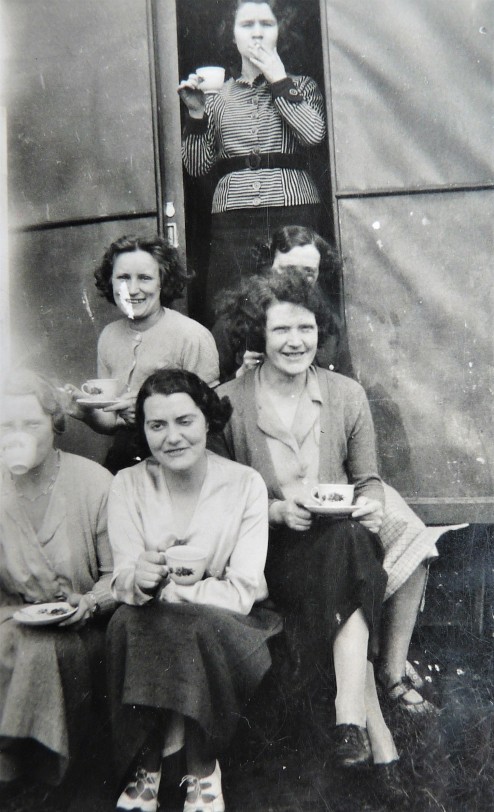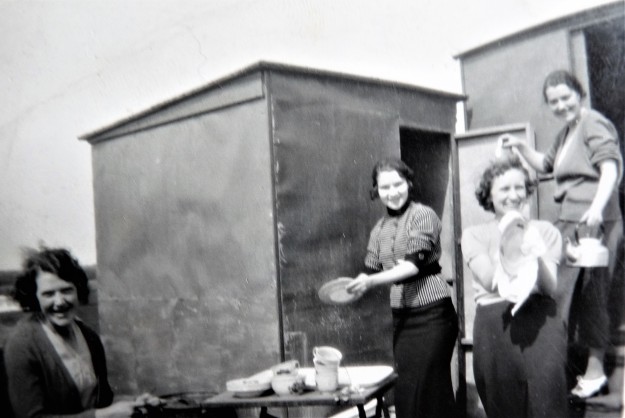Although my grandmother gave up her job as a dressmaker after her marriage to my grandfather in 1931, it would be another seven years before they had their first and last child – my mother. But continuing to work while married would have reflected badly on my grandfather’s ability to be a good husband who ‘kept’ his wife. Despite being relatively busy with housework, shopping and cooking, as well as visiting her parents and other members of her family, the new Mrs McKay’s day would not have involved such onerous tasks as previous generations had to undertake.
Throughout the 20s and 30s, houses were becoming electrified and gas cookers were being installed, removing the need to cook on a range and all the mess that entailed, including the weekly ‘blackleading’ (not to mention having to keep a fire going throughout the day, whatever the weather). Labour saving gadgets were also being introduced, and life was becoming easier for the housewife who could afford such items of the new modern age.
 Dumbiedykes ‘range’ (c) Wullie and Tam Coal @ EdinPhoto.org.uk
Dumbiedykes ‘range’ (c) Wullie and Tam Coal @ EdinPhoto.org.uk
In contrast to my grandmother, who actually would have preferred to have continued in her profession as a dressmaker at an upmarket Edinburgh department store, my great-grandmothers were no doubt relieved that they did not have to try to supplement the family income by going out to work. Typically of working class Victorian woman, they had toiled in factories or given up their independence to become domestic servants until their ‘real life’ as wives and mothers could begin. Such women did, however, often still have to work sporadically throughout their lives (in between having all those babies) with older children or relatives and neighbours looking after the younger ones when they were out at work.
This was particularly the case if husbands became sick or lost their job, or were absent for whatever reason. In these instances, women would have had little choice but to return to work as ‘day nurses’ to wealthy families, taking in laundry or piece work, or working factory shifts. Those who had room to spare might have taken in lodgers, as did my English great-grandmother (my grandfather being the young boarder who married the landlady’s daughter). At the other extreme, prostitution was an option many women had in the days when they could operate in this trade independently.
N.B. It is interesting to note that in 1921 the Edinburgh Trades Association reported in Industrial Edinburgh that: It is pleasant to be able to add that the “married woman” class in Edinburgh industry is conspicuous by its absence, and what this means to the home and social life of the worker and of the community, only those can appreciate who have lived and worked in centres where the factory mother is a regular feature.
 My great-grandmother, Janet McKay, at home with her children c1906
My great-grandmother, Janet McKay, at home with her children c1906
My Scottish great-grandmothers must have been relieved when they married kind and reliable men with stable jobs, and thus could focus all their energy on creating a family home. Nowadays we tend to dismiss this lifestyle as being an unfulfilling one, but from what I have heard from family anecdotes both women were relatively content in their roles and relished being the family organisers. It should also be emphasised that having the support that comes from a strong and loving marriage would have certainly made it easier to create a ‘happy home’ and to withstand any hardships that came their way.
 My great-grandmother, Catherine Neilson, at home on her ‘balcony’ c1910
My great-grandmother, Catherine Neilson, at home on her ‘balcony’ c1910
The above photographs of both great-grandmothers show them at home carrying out their daily chores, both maternal and domestic. Such images are rare in most family albums so they are very much treasured and among my favourites from the Scottish family collection. In the case of Catherine Neilson it would appear as if she is holding some sort of cleaning implement in her left hand (where her wedding ring glints) and is wearing a pinafore to protect her Edwardian-style clothes. Her rolled up sleeves also suggest that she is in the middle of some dirty household task, and the cheeky look that she gives the unknown photographer shows so much more of her personality than any forced studio pose could ever hope to do.
My grandmother once told me it was so rare for her mother to rest that she and her siblings all knew that if their mother was in bed in the morning when they left the house then a baby was imminent. When they returned later that day from school or work, in most cases they would have a new brother or sister waiting to greet them. My great-grandmother even had a system set up where she was able to use her foot to pull a string to rock the cradle in order to be able to continue sewing or knitting during the nights when the baby could not sleep, thus not wasting a minute of her time, and able to create a whole sock during this time. Even as an old lady, this fierce spirit shone through, right up until her final years when I only knew her as ‘Great Grandma’ and she still had the energy to play games with me.
 Catherine Neilson having a rare, enforced rest (by her daughters) in her 70s
Catherine Neilson having a rare, enforced rest (by her daughters) in her 70s
I wonder how Great Grandma felt when she saw all her nine living children having much smaller families throughout the 20s, 30s, and 40s, right up to the 50s when her youngest child (born when she was in her early 40s) had her second and last child at 38. This baby of the family, my great-aunt Mary, was the only woman I knew to work full-time and for that reason I was fascinated by her lifestyle. Widowed in her forties, Mary had no choice but to go back to the office until her retirement, but by the time I knew her well she was already in her 50s and living alone, and this seemed more of a lifestyle choice than anything else. Everything about her life as a single working woman seemed glamorous: from the fashionable Teasmade alarm clock by her bed to the selection of strange alcoholic drinks in her sideboard and the high heels and suits and clasp handbags in the wardrobe. Even the fact that she smoked Embassy Regal almost non-stop appeared more like a carefree choice rather than a dangerous addiction that she would battle with for a further two decades.
Great-aunty Mary, who was born in 1917, had been in the Women’s Auxiliary Air Force (known as the WAAFs) during the Second World War, and had enjoyed her work packing parachutes and sense of camaraderie she encountered there, and this was something she found again in midlife through her clerical job and her membership of the Foresters Friendly Society – a mutual aid organisation that also organised dances and social events. As a child, I always imagined the Foresters as some sort of secret society that encouraged my great-aunt to work and smoke and drink and dress up in gowns to dance the night away with handsome strangers! This was in direct contrast to the lifestyle of my grandmother, who had not only been constrained more by her traditional marriage, but personality-wise was a more serious and anxious person than her younger sister. In later life, when my grandmother was widowed too, the sisters (who had always been close) spent more time together, although always with a certain amount of good-natured bickering involved.
 Great Aunt Mary in the WAAFs, early 1940s
Great Aunt Mary in the WAAFs, early 1940s
Mary was also the only older relative I knew who could charm my father. He respected her and talked to her more like an equal than he did to my grandmother. Once more I put this down to her masculine lifestyle and her possession of a career, although their shared experience of the air force as well as my great-aunt’s sense of humour and lively personality probably had more to do with it. She was my favourite female relative after my grandmother, and when my grandmother died in 1998 she took over her role for the next decade. As she was very close to my mother all her life, I was given her name as my middle name. It was something I just took for granted until after she died and I realised the significance of the gesture.


 Camaraderie in the WAAFs (Mary is in the same striped top throughout)
Camaraderie in the WAAFs (Mary is in the same striped top throughout)
To be continued.
The Incidental Genealogist, March 2023

I just discovered your excellent blog last week and it inspired me to revisit my ancestry efforts. My grandmother is a strong Glaswegian still doing her thing at 101. I feel a sense of urgency now to record as many of her memories as possible before it;s too late!
LikeLike
Thank you for your positive comments. You are so lucky to still have your grandmother in your life. Yes, if you’ve got photos these can be excellent memory prompts or even just photos you can download of places etc. This is a more relaxed and productive way I feel of generating memories rather than a list of Qs – although that can obviously help, too. I have a post I wrote in my other blog about ‘interviewing’ my 94-year-old English aunt (who unfortunately recently passed away before I could get back to interview her after all the Covid lockdowns). I’ve put a link to it here if you are interested: https://alondonfamily.com/2019/09/01/return-to-east-coker/
LikeLike